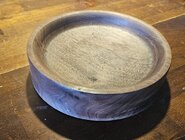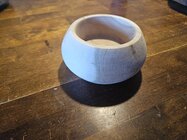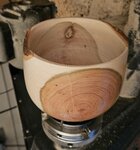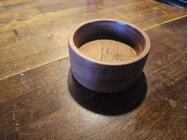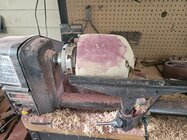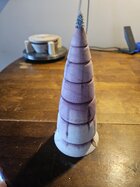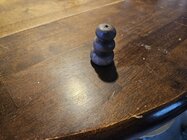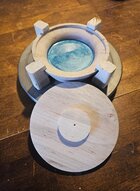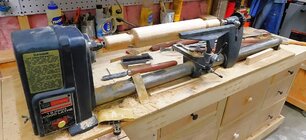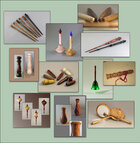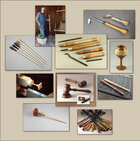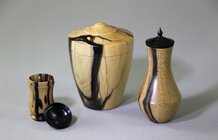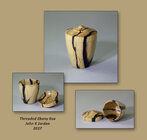Hello, Raymond. Looks like you are well on your way! You seem to be full of creativity, don’t let anyone steer you away from that!
What lathe are you using? Do you have chucks? What kind of tools?
One approach is to use what you have until you feel a real limitation then research upgrades. There are so many good lathes available today, it’s hard to go wrong with any of them. Good lathes are always expensive, just keep away from the cheap junk. Ask here about almost any lathe and you’ll probably hear from a gaggle of cheerleaders! And there is NOTHING wrong with buying a good used lathe. Three of my 5 lathes I bought used.
I’m pushing 75 and have been turning for almost 25 years now - I started with the worst cheap lathe ever made by humans just to make one thing, then was hooked like a Blue Marlin and bought a good lathe (still in my shop today as a second lathe). I do a lot of teaching and demos in clubs - many clubs have a strong mentoring program. While you can certainly take classes on bowl turning and such, I think you can learn quicker and build a wider variety of skills under a mentor since the teaching is one-on-one.
I like that you are adapting things with mistakes - excellent! The biggest thing is to turn as often as possible and turn as many different things as possible. “The more you turn, the more you learn, the more you learn, the less you burn!” When a student does make a mistake and feels horrified, I pull out my “Box ‘O Shame” and show them that EVERYONE does that at times, even after a lot of experience. Sometimes we can fix their piece, perhaps turning a contrasting piece to patch a funnel box and transform it from mistake to masterpiece!
Most people want to turn bowls, some only turn bowls (maybe bigger and bigger bowls) with perhaps some platters and hollow forms. Bowls are great, but there is an alternative path to consider, one recommended by many experts - if you learn spindle turning first, it will teach the fine tool control needed to turn anything with expertise, bowls included. Some well-know turners who have reinforced this: Richard Raffan, Keith Rowley, Mike Darlow, Jimmy Clewes, more. I’ve encountered bowl turners who couldn’t turn a spindle if they had to - many are even afraid of the most basic tool in the kit - the skew chisel. Even professional demonstrators sometimes make jokes about the skew: “Great for opening paint cans”, etc. Starting with spindle turning is not popular with many but one thing is guaranteed: it works.
For this reason, the first tool I put in a beginner’s hands is the skew, even if they have never seen a lathe before. I think it’s the best to learn how to let the edge interact with the wood to for controlled cuts. (Not one student has ever gotten a catch. I’ve taught remedial skew turning to some “oldsters” too who tried the skew long before, got a bad catch, then gave up. Some now use the skew often!) After the skew, we go to the spindle gouge, then the roughing gouge and a few other spindle tools, then later, learn how to turn a basic bowl - IMO bowls are the easiest things to turn! I personally have turned many, large and small, but I prefer the variety of turning many non-bowls things, thin spindles, ornaments, small lidded boxes (some threaded), lots of things for the kitchen and as gifts for friends.
I've posted these pictures before: these two college students came for a one day lesson - we learned the skew and spindles in the morning and they each made something to take home. After lunch they each did a practice bowl then a cherry take-home bowl. Good clean fun. (One now has her own lathe and turns a LOT!)
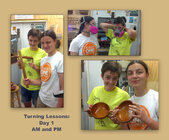
Fortunately, you live in a part of the country where good hardwood is easy to come by and basically free. Do you have a good bandsaw? (the second most important tool in the shop after the lathe, IMO.) Many of the things I like to turn are best made from dry wood which is sometimes hard to find and not always cheap. I like to cut up green log sections into useful turning blank sizes and dry them. I’ve cut and dried thousands of blanks over the years - if you process a few occasionally, eventually you’ll have more dry wood than you can use and plenty to give away! If interested in that, I have a post in the Tutorials/Tips section on this forum with some ideas in a video.
My “Logs to Blanks” video shows how I use a shop bandsaw to make useful turning blanks from log sections. I almost always turn dry wood so I include a little information on drying. I made this video during the Covid pandemic for a club Zoom meeting demo. It’s long, about 45 minutes, but it’s...

www.aawforum.org
JKJ
